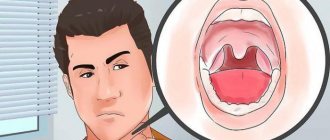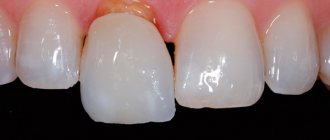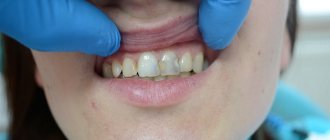Bad breath is a huge problem for many people who are forced to constantly “chew” it with chewing gum, use various fresheners and at the same time are still embarrassed to communicate normally. If you have to constantly "keep your distance" when talking, refuse spontaneous kisses (because you have to run to the bathroom first and brush your teeth immediately!) and spend a lot of money on fresheners, it may be easier to find the real cause of your bad breath and finally eliminate it ?
Tooth extraction: swelling
Tooth extraction is a difficult operation that traumatizes the tissue surrounding the tooth. Therefore, it is not surprising that unpleasant consequences occur after tooth extraction: the most common of them is swelling. Patients often complain that after tooth extraction, the gums become swollen, swelling of the cheek or a slight gumboil appears. This is caused by partial destruction of the soft tissue around the tooth. This is unpleasant, but if the tumor is small, it goes away on its own in 2-3 days. To relieve swelling after tooth extraction, ice can be applied to the cheek for about 10 minutes. If the swelling has not gone away after a day, apply heat. Keep the heating pad for 20 minutes, then take a break for 10 minutes and put the heating pad back on.
Sometimes swelling can be caused by an allergy to the anesthesia. In this case, histamine, an antiallergic drug, will help. But if the swelling increases, then it may be a sign of inflammation that has arisen after tooth extraction. In this case, you should immediately consult a doctor.
Causes of blood taste in mouth
Changes in taste during pregnancy
Pregnant women are characterized by sharp hormonal changes, which cause an increased sense of smell, changes in taste preferences and sensations. As a result, a specific metallic taste, perceived as the taste of blood, occurs when eating fully cooked meat products, fish or even vegetable dishes. The symptom occurs periodically and often goes away on its own after some time.
Anemia
The main reasons for changes in taste are a drop in hemoglobin and coagulation disorders, leading to capillary fragility. The taste of blood in the mouth is especially common in young women if anemia develops during pregnancy. Its persistence throughout the day, combination with painful nausea, the urge to vomit, indicates concomitant pathology (coagulopathy, hypovitaminosis). In the absence of gestation, an anemic change in taste is observed with chronic bleeding, neoplasia, etc.
Gingivitis
Chronic inflammatory disease of the gums occurs in 20-30% of the adult population. Usually, the taste of blood appears after brushing your teeth with hard toothbrushes, which cause trauma to the mucous membranes and bleeding gums. When gingivitis worsens, an unpleasant taste in the mouth is felt at any time of the day for no apparent reason. The symptom is accompanied by redness and swelling of the gums, and the formation of difficult-to-remove plaque on the teeth.
Other dental causes
A bloody taste in the mouth is detected in various pathological processes: medium and deep caries, pulpitis, periodontitis. The symptom can occur spontaneously, but is more often provoked by eating solid food and brushing teeth. A specific unpleasant taste of blood develops against the background of intense pain in the area of the diseased tooth. Odontogenic causes are dangerous due to their complications, so you need to visit a specialist as soon as possible.
ENT pathology
The taste of blood in the mouth often occurs with chronic rhinitis and sinusitis, in which atrophy of the mucous membrane occurs and scanty bleeding periodically begins. The bloody taste bothers you in the morning, when the blood that has accumulated overnight begins to flow down the back wall of the throat. The person experiences severe nausea and aversion to food. The discomfort disappears after rinsing your mouth and brushing your teeth.
Respiratory infections
Most often, the symptom occurs with influenza, for which a toxic effect on capillaries and spontaneous bleeding from the oral mucosa is pathognomonic. The taste occurs periodically in the first 2-3 days of infection, then disappears on its own. A similar clinical picture also develops in severe ARVI, pharyngitis and laryngitis.
Diseases of the gastroduodenal zone
GERD and gastritis are characterized by a taste of blood in the mouth after drinking alcohol, stress and heavy physical activity. In these diseases, the main reasons for the unusual taste are the formation of erosions in the mucous membrane of the digestive canal, which, under the influence of unfavorable factors, begin to bleed. Patients experience severe burning and pain in the chest, accompanied by an unpleasant sensation of blood in the mouth.
Cirrhosis
Fibrous liver damage provokes dilation of the esophageal veins and thinning of their walls, which is fraught with spontaneous bleeding. In the mouth of patients with cirrhosis, a strong taste of blood suddenly begins to be felt, and with massive bleeding, vomiting of dark red blood begins. The symptom occurs more often in men who abuse alcohol. If there is a suspected rupture of esophageal varicose veins, a person needs emergency medical care.
Cardiovascular disorders
The symptom is determined by hypertension, vasculitis, which is accompanied by thinning and fragility of the capillaries. A specific blood taste appears after physical activity or stress, leading to a rise in blood pressure and rupture of small blood vessels. During an attack of angina, accompanied by pain in the heart and shortness of breath, sometimes there is a feeling of an unpleasant taste of blood in the mouth.
Rare causes
- Diseases of the respiratory system
: bronchial asthma, chronic obstructive pulmonary disease, tuberculosis. - Poisoning with heavy metals
: lead, mercury, cadmium, etc. - Gastrointestinal pathology
: pancreatitis, cholecystitis, hepatitis. - Tumors
: malignant neoplasms of the oral mucosa and tongue, lung cancer.
Pain after tooth extraction
Another common complaint is that after tooth extraction, the gums, adjacent tooth, jaw, and throat hurt. As a rule, these are common symptoms after a traumatic procedure. They are caused by damage to the periodontal tissues and nerves, which goes away on its own after a few days. For example, if a temporary aching pain appears after tooth extraction, this is normal. To relieve discomfort, you can take painkillers. But if the pain intensifies, it is still worth visiting a doctor.
Bleeding after tooth extraction
Immediately after a tooth is removed, there is bleeding from the socket. This is quite normal, since blood vessels rupture during surgery. In this case, the doctor will provide you with the necessary assistance. But sometimes bleeding occurs a few hours after surgery. To stop the bleeding yourself after tooth extraction, apply a small gauze swab to the hole and lightly bite it. After 15 minutes the blood stops flowing. But if the bleeding does not stop for a long time, you should consult a doctor.
Complications after prosthetics
- The development of inflammation of the gingival tissue - as a result, leads to gingivitis, stomatitis in acute and chronic forms. As a rule, such a complication in the oral cavity occurs due to poor fit of the tooth replacement structure. The process goes like this: the structure puts pressure on the tissue, blood vessels die, there is no blood supply to the tissue, and inflammation develops.
- Carious formations - as a result, the supporting teeth are affected by pulpitis or periodontitis. This usually occurs due to the accumulation of food debris between the prosthetic structure and living tissues. The problem leads to the fact that the teeth are gradually destroyed, cease to perform their supporting functions, and the fixation of the prosthesis is disrupted.
- Infectious lesions of soft and bone tissues – periodontitis. Often obvious destructive changes are noticeable around the product: the gums acquire a bluish tint, swelling and bleeding of the tissue develops. As a result, this leads to tooth loss and disruption of the fixation of the replacement structure.
- Rejection of the structure due to an allergic reaction. It can manifest itself as swelling of the gums, itching, rash and redness in the mouth. In some cases, difficulty breathing and a constant feeling of dry mouth and fever may occur. Allergies may appear in the first few hours after installation of the structure or after several weeks.
- The development of galvanism leads to the generation of galvanic current. What usually happens when using structures with a metal frame is that saliva gets on the material, the patient feels a taste of iron in the mouth, a constant feeling of an acidic environment in the oral cavity, and discomfort. As a result, the crowns darken, aesthetics are impaired, and sometimes the problem is accompanied by a headache.
- Poor quality fixation of the product. As a rule, the product “sits” on a special dental cement, which does not always hold the product in the oral cavity. The prosthesis may come off due to overload, incorrectly selected shape or size of the prosthesis. It is also possible that the dentist did not use enough dental cement for bonding. Sometimes fillings on the teeth prevent the prosthesis from “adhering” to living tissue.
- Product deformation. These can be chips, cracks, breaks, breaks into halves or small parts. The denture can become deformed due to impacts to the jaw projection, accidents, falls, or eating too hard foods. Sometimes the product is deformed due to errors in prosthetic planning.
- Problems with the occlusal plane. We are mainly talking about the surface that passes through the cutting edges of the first incisors of the lower jaw and the tubercles of wisdom teeth or second molars. The plane may shift, causing the temporomandibular joint to suffer.
- Change in bite. The height of dental crowns plays a big role. For example, with a lack of height, the quality of chewing decreases - a low-quality food bolus is formed. When the height of the crowns is high, the jaw is overloaded, which provokes dysfunction of the temporomandibular joint.
How to solve a problem?
The dentist recommends treating the oral cavity with antiseptic solutions, as well as special gels to activate tissue regeneration processes. With regular treatment and oral care, the gums are soothed.
How to solve a problem?
At least twice a year (or even more often) undergo a full examination by a dentist. Not a single prosthesis, even a well-made one, will stand in such a way that bacteria will not accumulate under it. Care for the cavity with such products should be twice as thorough as usual!
How to solve a problem?
First, the dentist must prepare the teeth without creating so-called ledges. Secondly, the design must be selected strictly; several fittings and adjustments of the product may be required. Thirdly, before installing a prosthetic product, it is necessary to treat the gums. Regular therapy may be needed to maintain the health of the oral soft tissues.
How to solve a problem?
It is necessary to establish which component of the prosthetic structure the patient is allergic to. Most likely, the prosthesis will have to be replaced. That is why, at the stage of planning prosthetics, it is important to study the medical history and make sure that the patient does not have an allergy to metal.
How to solve a problem?
Replace the prosthesis with a product made of ceramic material. When installing ceramic structures, galvanism does not occur.
How to solve a problem?
Determine exactly why the prosthesis is poorly fixed and perform re-fixation with correction of inaccuracies.
How to solve a problem?
If the deformation is minor, the structure can be repaired directly in the oral cavity. Sometimes removal and re-fixation may be necessary. If the damage is serious, the prosthesis will have to be removed and a new one put in its place.
How to solve?
Since the problem is global, most likely, it is necessary to re-plan the prosthetics with a thorough diagnosis of the bite and the production of a new prosthetic structure.
How to solve a problem?
Determine the main cause of the development of malocclusion, re-plan prosthetics with replacement of the structure.
Pus after tooth extraction
Suppuration of the socket and periodontal tissues is caused by their infection. It can happen for several reasons. Firstly, if you did not follow the dentist's instructions regarding individual oral hygiene after surgery. Secondly, the cause may be a tooth fragment remaining in the tissues after removal. Thirdly, there is a high risk of suppuration after a complex wisdom tooth extraction, for example. If the inflammation is not treated in time, then some time after removal, suppuration, a fistula on the gum, and even a cyst may appear. If pus appears at the surgical site, consult a doctor. He will find and eliminate the cause of the inflammatory process.
How to get rid of odor at home
If you have bad breath after tooth extraction, you can use traditional medicine in addition to drug therapy. With normal daily discomfort, there is no need to worry. The danger is the development of the inflammatory process. To fix the problem:
- Rinse your mouth thoroughly after eating with plain water or infusions of herbs such as sage or mint.
- To clean your tongue you need to use a specific brush.
- Avoid fast food and junk food.
- Use a decoction of chamomile and calendula. These are powerful tools for fighting inflammation. They promote wound healing. It’s not difficult to prepare a mouthwash: 1 tbsp. l. herbs are poured with 1 liter of boiling water. You need to leave for half an hour, then rinse.
- A golden mustache is often used. To carry out the procedure, squeeze the juice from the plant, then pour boiling water over it.
- Traditional healers recommend rinsing your mouth with a decoction of eucalyptus. This plant perfectly relieves the inflammatory process.
Dry socket after tooth extraction
A blood clot should remain in the socket after surgery. This is a very important part of the healing process. This clot protects the bone and nerve endings and serves to form bone tissue after tooth extraction. Therefore, you should not rinse your mouth for a day after the procedure and eat hot food - this will help the clot dissolve. But sometimes it does not form, and a dry socket appears.
Dry socket is considered a complication. It most often occurs after complex removals accompanied by significant trauma. If there is no blood clot, then the hole after tooth extraction hurts, and sometimes it seems that the ear also hurts. Often there is an unpleasant taste in the mouth. The consequence of a dry socket after a traumatic tooth extraction can be inflammation of the gums or alveolitis. Therefore, if you experience acute pain in the socket, consult a doctor immediately. He will place a tampon with a special anti-inflammatory gel on the hole. Tampons are changed until healing begins.
Diagnostics
To find out the cause of the taste of blood in the mouth, the patient is referred to a general practitioner, and if he complains of toothache, to a dentist. During the initial examination, typical etiological factors of unpleasant taste sensations are excluded, and modern imaging methods are used to clarify the diagnosis. Taking into account the probable cause of the disorder, the following studies have the greatest diagnostic value:
- Oral examination
. Using a probe and a special mirror, the condition of the gums and oral mucosa is assessed, and the crowns of the teeth are examined in detail. To diagnose caries, vital staining with methylene blue and a cold test are performed. If suspicious ulcers and tumors are detected, a biopsy and cytological examination are indicated. - Blood analysis
. To exclude anemia, a general blood test is done, the level of hemoglobin and red blood cells is checked. Leukocytosis and increased ESR indicate the presence of an inflammatory process. In women, hCG levels must be measured to confirm or rule out pregnancy. If necessary, serological tests are recommended. - Radiography
. X-rays of the jaws are performed to detect periodontitis, granulomas and cystic formations. To exclude sinusitis, radiography of the paranasal sinuses is prescribed. If the taste of blood is combined with a sore throat or cough, a plain X-ray of the chest cavity is performed. - Other visualization techniques
. Endoscopy allows you to diagnose symptoms of inflammation of the mucous membrane of the stomach and esophagus, and incoordination of the lower esophageal sphincter. Targeted ultrasound of the liver is informative for identifying signs of cirrhosis. To exclude a cardiac cause of unpleasant taste, echocardiography data are indicative.
Alveolitis after tooth extraction
This is a serious complication caused by tooth extraction, which has several causes. This may be the presence of chronic inflammation of the tissues around the tooth - periodontitis, or a dry socket. In addition, alveolitis occurs if, after tooth extraction, a dental fragment remains in the tissues. All these factors cause infection of the hole and the development of its inflammation. 1–3 days after tooth extraction, pain occurs, followed by a specific smell from the mouth. Then these symptoms intensify, the hole becomes covered with a gray coating, and it becomes impossible to eat due to severe pain.
In this case, only a doctor will help you, who will carry out the necessary treatment and clean the hole from infection. Do not self-medicate under any circumstances - alveolitis can develop into periostitis (inflammation of the periosteum), causing an abscess and phlegmon.
Painful sensations after the removal procedure are unpleasant, but inevitable. Remember, if these sensations intensify, then in this case, complications after tooth extraction should be treated by a specialist. Do not delay visiting the dental clinic, dulling the pain with analgesics. Correct and timely treatment will help you avoid more serious complications.









